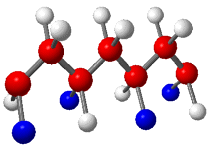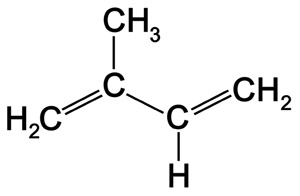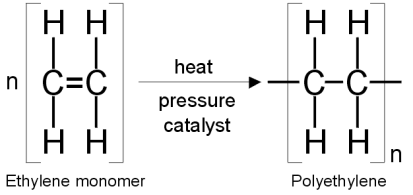What is Polymer?
A polymer is a high molecular mass compound ranging from 5000 to one million and they are formed by the combination of a large number of one or more low molecular weight compounds. The unit substance or substances from which the polymer is obtained is called a monomer. The process by which the polymers are formed is called polymerisation.
For example, polythene is obtained from its monomer ethylene as a result of polymerisation. The repeat unit is derived from the monomer, ethylene.

In certain cases, the repeat units are derived from two different monomers (e.g. nylon- 66, carbohydrates, proteins). Thus polymers obtained from only one type of monomers are called homopolymers ( e.g. polyethene) while those obtained from two or more different types of monomers are called copolymers ( e.g., nylon, bakelite). Polymers are obtained from both organic and inorganic molecules. Some inorganic polymers are metaphosphoric acid (HPO3)n, silicates and silicones.
Classification of polymers:

Classification based on source of availability:
1. Naturally occurring polymers:
These occur in plants and animals and are very essential for life. These include starch cellulose, proteins, nucleic acids and natural rubber. Starch is a polymer of glucose, cellulose is also a polymer of glucose, proteins are polymers of amino acids. Natural rubber consists of repeat units of isoprene (2-Methyl-1,3-Butadiene).

2. Semi -synthetic polymers:
These are mostly derived from naturally occurring polymers by chemical modifications. Cellulose on acetylation with acetic anhydride in presence of sulphuric acid forms cellulose diacetate used in making threads and materials like films, glasses etc. Vulcanised rubber has much improved properties and is used in making tyres etc. Gun-cotton , which is cellulose nitrate, is used in making explosives.
3. Synthetic polymers:
The polymers which are prepared in the laboratory are called synthetic polymers. These are also called man made polymers . These include fibres, plastics and synthetic rubbers and find diverse uses as clothing, electric fittings, eye lenses, substitute for wood and metals.
Classification based on Mode of polymerisation:
1. Homopolymers and Copolymers
Polymers when made by polymerisation of a single monomeric chemical species are known as homopolymers. Polythene formed from ethylene is a homopolymer.

When the polymers are synthesised by polymerisation of two or more than two different monomers, they are called copolymers. When styrene and butadiene are polymerised, it gives the copolymer called styrene-butadiene rubber.
2. Addition and condensation polymers:
(a) Addition Polymers:
A polymer formed by the direct repeated addition of monomer is called addition polymerisation. In this type of polymers, the monomers are unsaturated compounds and are generally derivatives of ethene. For example , the addition polymers polyethene and polypropylene are obtained as :

(b) Condensation Polymers:
Condensation polymerisation involves a series of condensation reactions generally involving two different monomers. Each monomer normally contains two functional groups. During these reactions, there is a loss of small molecules usually water. Some of the condensation polymers are ; nylon, terelene, alkyd resins, bakelite.
Recent Method of Classification:
In many polymerisation processes, it is difficult to find out whether the polymerisation has occurred through addition or condensation. Therefore the polymers has been classified according to the mode of addition of monomers. The polymerisation has been divided into two types.
- Chain growth polymerisation.
- Step growth polymerisation.
i. Chain Growth Polymerisation:
Chain growth polymerisation involves a chain reaction. Therefore it requires an initiator like organic peroxide to form free radical. These free radicals are added to another monomer forming another free radical. The process results in the formation of chain and ultimately a polymer is formed. This is known as chain growth polymerisation. The initiators are added in small quantities. Examples :

ii) Step Growth Polymerisation:
This type of polymerisation is due to the condensation process which takes place in several steps. The condensation process may or may not be accompanied by elimination of smaller molecules such as water etc. Examples,

Classification based on Structure:
On the basis of structure of polymers, these can be classified as :
- Linear chain polymers
- Branched chain polymers
- Crossed linked polymers.
(i) Linear Chain Polymers:
These are polymers in which monomeric units are linked to form linear chains. These linear polymers are well packed and therefore have high densities, high tensile strength and high melting points. For example, polythene, nylon and polyesters are linear chain polymers.
(ii) Branched Chain Polymers:
These are polymers in which monomers are joined to form long chains with branches of different lengths. Fig (b) These branched chain polymers irregularly packed and therefore, they have low tensile strength and melting points than linear polymers. For example, low density polyethene , glycogens etc.
(iii) Cross-linked Polymers:
These are polymers in which monomer units are cross- linked together to form a three-dimensional net work. These polymers are hard, rigid and brittle because of network structure. These are shown in Fig (c) . For example melamine formaldehyde resin bakelite etc.
Classification based on Molecular Forces:
The intermolecular forces present in polymers are van der waal’s forces and hydrogen bonding. Although these are weak forces but in macromolecules (polymers) , these forces have accumulative effect all along the chain of polymers. Polymers are thus classified into four categories on the basis of magnitude of these intermolecular forces in them.
(i) Elastomers:
In these polymers, the chains are held together by weakest intermolecular forces which permit the polymers to be stretched. A few ‘cross-links’ are introduced between the chains which help the polymers to regain its original position, when the force is released. e.g., vulcanised rubber.
(ii) Fibres:
These polymers possess high tensile strength and are used in making fibres. This is due to the strong inter nuclear forces like hydrogen bonding which operate, for example in nylon-66(a polyamide). These forces also lead to close packing of chains and thus give crystalline nature. Because of that, these polymers show sharp melting points.
(iii) Thermoplastics:
These are polymers in which the intermolecular forces of attraction are mid-way between those of elastomers and fibres. Due to that, these can be easily moulded by heating. In thermoplastic polymers, there exists no cross-linking between chains. Examples of these polymers are polyethylene, polystyrene etc.
(iv) Thermosetting polymers:
These are prepared from low molecular mass semifluid substances. When heated in a mould, they get highly cross-linked to form hard infusible and insoluble products. The common example is bakelite.

Not good because no matter for preparing exams give more matter for preparing exams please 🙏🙏
This notes are very useful to me. Thank u .